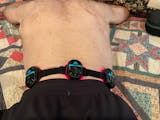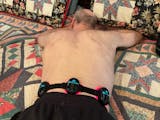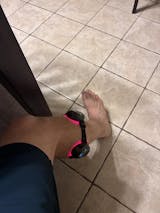Frozen shoulder, medically known as adhesive capsulitis, is a condition that causes significant pain and stiffness in the shoulder joint. This disorder typically develops slowly, leading to a gradual decrease in shoulder mobility. In this article, we will explore the causes, symptoms, treatment options, and the role of red light therapy module in providing relief and accelerating recovery from frozen shoulder.
What Is Frozen Shoulder?
Definition and Medical Explanation
Frozen shoulder occurs when the capsule surrounding the shoulder joint thickens and tightens, restricting movement. This can result in chronic pain, especially during certain activities like lifting the arm overhead or reaching behind the back. It's a gradual process that can last for months or even years, but it is treatable.

Common Symptoms of Frozen Shoulder
People with frozen shoulder often experience pain in the outer shoulder, which becomes more intense at night. As the condition progresses, the shoulder becomes increasingly stiff, making it harder to perform everyday tasks such as dressing or reaching. In severe cases, the shoulder may freeze, making any movement extremely painful.
Stages of Frozen Shoulder
Frozen shoulder typically develops in three stages: the freezing stage, where pain gradually increases and range of motion decreases; the frozen stage, where pain may subside but stiffness remains; and the thawing stage, where mobility gradually returns, and pain reduces. Each stage can last several months, but with proper treatment, recovery is possible.
What Causes Frozen Shoulder?
Inflammation and Scar Tissue Formation
Frozen shoulder often starts with inflammation of the shoulder joint's soft tissue. Over time, this inflammation can lead to the formation of scar tissue within the shoulder capsule. The scar tissue makes the shoulder stiff and less mobile, restricting its range of motion and causing persistent pain.
Risk Factors for Developing Frozen Shoulder
Certain factors increase the likelihood of developing frozen shoulder. People with diabetes, those recovering from surgery or injury that limits shoulder movement, and individuals between the ages of 40 and 60 are more prone to this condition. Hormonal changes and previous shoulder injuries can also play a role in the development of frozen shoulder.
Autoimmune and Genetic Factors
While the exact cause is not always clear, autoimmune conditions and genetic factors may contribute to frozen shoulder. For some individuals, the immune system may trigger an inflammatory response in the shoulder joint, leading to the condition. Family history may also increase the risk of developing frozen shoulder.

How Is Frozen Shoulder Diagnosed?
Physical Examination and Range of Motion Tests
Doctors typically diagnose frozen shoulder by conducting a physical exam and assessing the shoulder's range of motion. They will check for pain and stiffness, which are telltale signs of the condition. Limited mobility, especially when trying to rotate the arm or move it overhead, is often a key indicator.
Imaging Tests for Frozen Shoulder
While a physical exam is often enough to diagnose frozen shoulder, imaging tests like X-rays or MRI scans can help rule out other conditions such as arthritis or a rotator cuff injury. These tests are used to confirm that the stiffness and pain are caused by frozen shoulder rather than other underlying shoulder issues.
Traditional Treatments for Frozen Shoulder
Physical Therapy
Physical therapy is often the first line of treatment for frozen shoulder. A therapist will guide you through stretching and strengthening exercises designed to improve mobility and reduce stiffness. Regular physical therapy sessions can help restore the range of motion and alleviate pain in the shoulder over time.
Medications for Pain Relief
Over-the-counter pain relievers such as ibuprofen or acetaminophen are commonly used to manage the pain associated with frozen shoulder. In more severe cases, corticosteroid injections can be administered to reduce inflammation and offer longer-lasting relief from discomfort.
Surgery as a Last Resort
In cases where physical therapy and medications are not effective, surgery may be considered. Procedures like shoulder arthroscopy or manipulation under anesthesia can be performed to remove scar tissue and improve the range of motion. Surgery is typically reserved for severe cases that do not respond to conservative treatments.

The Role of Medical-Grade Red Light Therapy Devices
How Red Light Therapy Helps Relieve Shoulder Pain
red light therapy module work by using light wavelengths to penetrate deep into the tissue, promoting better circulation and reducing inflammation. This helps alleviate pain and speeds up the body's natural healing processes. Regular use of red light therapy has been shown to help improve the range of motion in frozen shoulder patients.
Benefits of Medical-Grade Devices Over Home Devices
Unlike over-the-counter or home-use red light therapy devices, medical-grade devices are designed to provide more powerful and targeted treatment. They emit higher intensity light, which can penetrate deeper into the tissue, offering faster and more effective relief from shoulder pain and stiffness.
How Long Should You Use Red Light Therapy for Frozen Shoulder?
For optimal results, it's recommended to use red light therapy module consistently over a period of weeks. Most patients see significant improvement in flexibility and pain reduction after several sessions. The exact duration may vary based on the severity of the condition and the device used.
Alternative Therapies for Frozen Shoulder
Acupuncture and Dry Needling
Acupuncture and dry needling are alternative therapies that involve inserting thin needles into specific points around the shoulder. These treatments help stimulate the body's healing processes, alleviate pain, and improve mobility by targeting trigger points and muscle tension in the affected area.
Heat and Cold Therapy
Alternating between heat and cold applications can be an effective way to manage frozen shoulder. Cold therapy reduces inflammation and numbs the area to reduce pain, while heat therapy helps relax tight muscles and increases blood flow, promoting healing and flexibility in the shoulder.
Stretching and Mobility Exercises
Gentle stretching exercises aimed at improving shoulder flexibility are crucial for recovery. It's important to start slowly and avoid pushing the shoulder beyond its current range of motion to prevent further damage. Regular practice of stretching exercises can gradually improve the mobility of the shoulder joint.

Preventing Frozen Shoulder
Importance of Shoulder Mobility Exercises
Regular shoulder mobility exercises are essential for preventing frozen shoulder, particularly if you are at risk due to factors like diabetes or previous shoulder injuries. By maintaining good range of motion in the shoulder joint, you can reduce the likelihood of developing stiffness and pain in the future.
Avoiding Prolonged Immobilization
If you are recovering from shoulder surgery or an injury, it's important to avoid keeping your shoulder immobilized for too long. Keeping the shoulder joint moving within a safe range helps prevent the formation of scar tissue, which is a major contributor to frozen shoulder.
Managing Underlying Health Conditions
Proper management of health conditions such as diabetes can significantly reduce the risk of frozen shoulder. If you have an existing shoulder injury or surgery history, working with a physical therapist or healthcare provider can help ensure that you’re taking steps to protect the shoulder from stiffness and pain.
Can Frozen Shoulder Be Fully Reversed?
Recovery Time and Prognosis
Recovery from frozen shoulder can take time, but it is possible to fully regain the shoulder's range of motion with appropriate treatment. For most people, it can take anywhere from six months to two years to recover completely, depending on the severity of the condition and the treatment plan.

The Impact of Red Light Therapy on Recovery
Medical-grade red light therapy devices - PRUNGO FluxGo can play a significant role in accelerating recovery from frozen shoulder. By promoting healing, reducing inflammation, and enhancing mobility, red light therapy helps speed up the recovery process, often reducing the time needed to regain full shoulder function.
Conclusion
Frozen shoulder is a challenging condition that causes pain, stiffness, and limited range of motion. However, with proper treatment and consistent care, recovery is possible. Medical-grade red light therapy devices offer a non-invasive and effective solution to alleviate pain and improve mobility in patients with frozen shoulder. For those seeking advanced treatment options, Prungo's range of products, including the Red light panel and red light therapy mask, are designed to provide targeted relief and accelerate the healing process. If you're dealing with frozen shoulder, incorporating these devices into your recovery plan could make a significant difference.
















Share:
The Science of Synergy: How Our Dual-Light Engine Works
Does Red Light Therapy Tan You